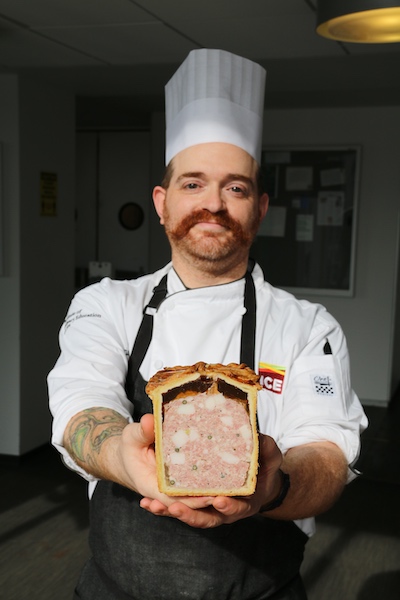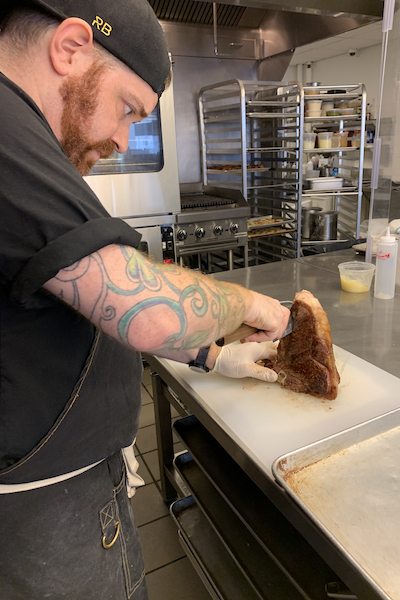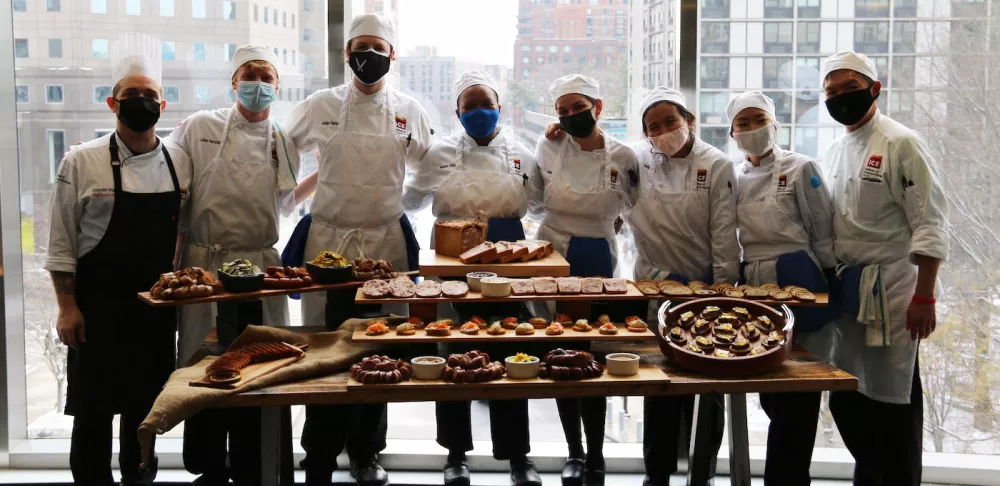Culinary Arts Chef-Instructor Chris Arturo gained industry experience in New York and New Jersey, notably at the Saddle River Inn and the Ani Ramen House. He's also worked a few shifts at the James Beard House and knows a thing or two about butchery and charcuterie.
Chef Chris Arturo has a lot of stories to tell, and he’s bringing them into the classroom. The long-time chef started out running a Barnes & Noble and then worked at a Guitar Center selling half-million-dollar instruments, but in his mid-20s Chef Chris made the jump into the culinary arts and never looked back.
In the time since, he’s helped open 10 restaurants, cooked at the James Beard House nearly a dozen times, catered events for thousands of people, made countless bowls of ramen and seared an endless number of steaks. Now he’s bringing all of that experience with him to ICE.

“Every person that's been a chef is a teacher,” Chef Chris says. “You get the new person on the line, you have to teach them, and any chef that is worth their salt ... has to do it in a way that is positive, that's engaging.”
The Paterson, New Jersey native got his first gig at Shorty’s .32, a restaurant from Josh Eden in Manhattan’s Soho neighborhood. Then Chef Chris “bounced around” a lot, but he always seemed to be around friends. He worked under Mike Carrino, chef and eventual best man at his wedding, as sous chef at Passionne in New Jersey. A few years later Chef Chris would follow his close pal to Pig & Prince, a restaurant with terrazzo floors, vaulted ceilings and a “great wine cellar” where the two chefs would break down whole pigs nearly every week and make their own charcuterie.
From there Chef Chris went to Upstairs, a restaurant in Montclair, New Jersey, where he worked opening night. In 2016, he joined Ani Ramen House in Jersey City, a 100-seat restaurant about a month before open, to run the kitchen. By then Chef Chris was a seasoned pro at opening house doors to the public.
“Sirio Maccioni put it best. I think he said, ‘I've opened three restaurants in my life, and I feel them all in my knees,’” Chef Chris says. “There's nothing like it, and the thing about it is that the first three, four [restaurant openings], I not only learned what to do but also what not to do.”
In between his time at Upstairs and Ani Ramen House, Chef Chris was at Nico, the restaurant inside the New Jersey Performing Arts Center, as a tournant — the do-it-all person in the kitchen. He says he’d come in at 7 a.m., work on pastry until lunch prep, cook lunch until 2:30 p.m., and then stay through dinner service or prepare for an upcoming gala. Feeding 5,000 people wasn’t always easy, but Chef Chris says he learned a lot of useful tips, tricks and organizational techniques from his time at Nico.
All of these experiences get folded into hands-on lessons in the classroom. In between teaching students how to par-cook risotto ahead of service or turn brioche bread dough into doughnuts, Chef Chris sprinkles in real-world stories to help prepare students for their next steps after ICE.
“As much as we teach even something as simple as ingredient identification, there's usually a story for everything,” Chef Chris says. “Some of those stories are funny, which make them more memorable, I guess, but there's what you learn from a book in the classroom and then there's the real world. And I'm always going to be the guy that says both.”

One of Chef Chris’ career highlights has been cooking at the James Beard House 11 times. Another friend, Adam Rose of Villalobos, a Mexican restaurant where Chef Chris briefly worked, was invited to cook at the James Beard House several times and asked Chef Chris to help him make the meals. For one service they nixtamalized their own corn to make masa, using the dough to make fresh tortillas for tacos.
His last stop before becoming an educator was as chef de cuisine at the Saddle River Inn in New Jersey, where Chef Chris said he learned to cook steaks as well as he does. He still goes back about every three weeks to help out.
“When you become the chef of a restaurant, or even if you get up to sous chef or you're expediting, the reason why you can do that is because you know that particular salad takes this long. The person cooking the fish hasn't started yet … pasta guy’s lagging … You need to have all those things in your head, all at the same time,” Chef Chris says of the dynamics of a fast-paced kitchen. “Now all those things are in your head at the same time, and then you organize and control the chaos. You're just a conductor at that point.”
Chef Chris began teaching culinary arts at the International Culinary Center (ICC) in 2019 before the school closed in 2020 and he came to ICE's New York campus.
Study with Chef Chris in Culinary Arts at ICE.




